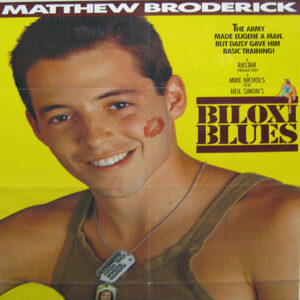calsfoundation@cals.org
Biloxi Blues
Biloxi Blues is a 1988 movie made entirely in Arkansas. Shooting locations included Van Buren (Crawford County), Fort Smith (Sebastian County), Barling (Sebastian County), and Fort Chaffee, which lies just outside Fort Smith and Barling. Trestle bridge shots took place at Frog Bayou, near Dyer (Crawford County), and a nighttime train scene was shot at Chester (Crawford County). The film, written by Pulizer Prize–winning humorist, screenwriter, and playwright Neil Simon, is semi-autobiographical with elements of both comedy and drama. It was directed by Academy Award winner Mike Nichols, and it starred Matthew Broderick along with Academy Award winner Christopher Walken.
Simon was on set in Arkansas with the rest of the cast and crew during the filming. Although Nichols and Simon had previously worked together on a number of other movies and Broadway shows, Biloxi Blues is known as their final professional collaboration.
In 1985, Simon had written a semi-autobiographical play of the same title. Biloxi Blues was the second in what is known as the “Eugene trilogy,” with the first being Brighton Beach Memoirs and the third being Broadway Bound. He adapted Biloxi Blues for the screen, maintaining the characters and plot elements of the play. Broderick, who played the leading role of Eugene Morris Jerome when the Tony Award–winning show ran on Broadway, reprised the role in the movie.
The story is centered around Eugene, a twenty-year-old Jewish boy from New York City. Toward the end of World War II, he is drafted into the U.S. Army and sent to basic training in Biloxi, Mississippi. Never having traveled beyond the familiar world of New York, Eugene must interact with a diverse group of soldiers from all over the country as well as cope with a bizarre drill sergeant played by Walken. Along the way, Eugene also has his first sexual encounter and later falls in love with a local girl, played by Penelope Ann Miller, at a United Service Organizations (USO) dance. The film’s soundtrack evokes the era by including songs from the 1940s. While it garnered mixed reviews, Vincent Canby of the New York Times called it “a first-rate service comedy.”
All of the filming locations were in Arkansas, with Fort Chaffee standing in for Simon’s real-life basic training camp in Biloxi. The filming began in March 1987, lasting about ten weeks. The USO dance was shot at Barling’s city hall. Scenes representing downtown Biloxi were shot in Van Buren, with the soda shop scene being filmed at 800 Main Street. Van Buren’s former Frisco rail depot served as a backdrop for what was portrayed as the troop train. On the way to Van Buren, the train made a stop in Arkansas for the crew’s lunch break in Winslow (Washington County). As the movie’s title shots run, including a close-up of Broderick, the train is seen crossing the Arkansas River on Fort Smith’s railroad bridge as it heads toward Van Buren.
Much of the movie was filmed at Fort Chaffee. According to Associated Press reports, Universal Studios executive producer Joseph Caracciolo said Fort Chaffee was chosen because of the success of A Soldier’s Story (1984), which had also been filmed there. The New York Times reported that Caracciolo said he hired 900 extras from the area around Fort Chaffee to play army trainees.
Nichols is reported to have enjoyed his experience in Arkansas, except for the chiggers, he joked. In addition to often taking the cast and crew to Fort Smith for pizza, he once drove Simon and a few Jewish actors to Fort Smith to attend a Passover seder there. One time, Nichols had to deal with local law enforcement officials after a young cast member got into some minor mischief.
The movie company spent about $3 million in the region, including a nominal sum paid to the army for use of the 9th Street Barracks at Fort Chaffee. Production credits for Biloxi Blues include the Fort Smith Chamber of Commerce.
For additional information:
“Biloxi Blues.” Internet Movie Database. http://www.imdb.com/title/tt0094746/ (accessed September 30, 2021).
Gordon, William A. Shot on This Site: A Traveler’s Guide to the Places and Locations Used to Film Famous Movies and TV Shows. Secaucus, NJ: Citadel Press, 1996.
Halloran, Richard. “Fort Chaffee Journal; From Training Ground to Film Set.” New York Times, February 8, 1988. Online at http://www.nytimes.com/1988/02/08/us/fort-chaffee-journal-from-training-ground-to-film-set.html (accessed October 20, 2020).
Harris, Mark. Mike Nichols: A Life. New York: Penguin, 2021.
Nancy Hendricks
Garland County Historical Society
 Divergent Prosperity and the Arc of Reform, 1968–2022
Divergent Prosperity and the Arc of Reform, 1968–2022 Biloxi Blues Poster
Biloxi Blues Poster 




Comments
No comments on this entry yet.